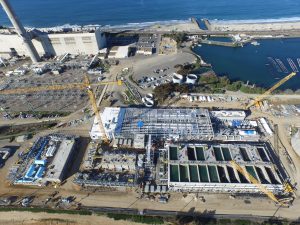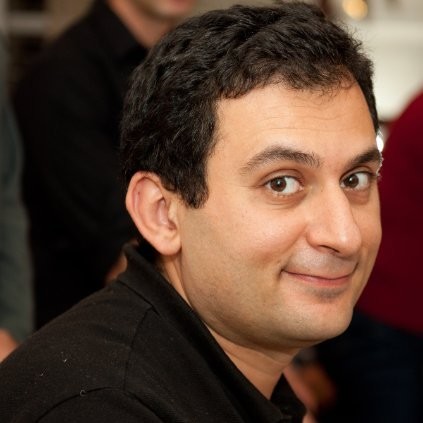Across industries, the move toward sustainability is no longer optional — it’s essential. .
How the Carlsbad Water Desalination Plant became a game changer for desalination in the US

Let’s start with some facts:
The Carlsbad reverse osmosis desalination plant in San Diego County, California produces around 50 million gallons of desalinated seawater a day (MGD) and provides 10% of the total drinking water needed by San Diego, delivering potable water to 400,000 people.
How did a foreign and relatively unknown company from Israel become the designer and operator of the largest desalination plant in the western hemisphere?
Back to the 90s
In the early 1990s, San Diego was experiencing drought conditions. In 1991, MWD (the Metropolitan Water District of Southern California) cut San Diego’s supply by 31 percent. In response, the San Diego business community sought alternative water sources for the 3 million people and extensive farmland in the region. Officials at the San Diego Water Authority recognized desalination as a highly reliable and essential component of their overall water supply portfolio. That was the beginning of the long and bumpy journey to what is known today as the Carlsbad Desalination Plant.
Who’s afraid of desalination?
The Carlsbad Desalination Project had been in development since 1998 but it was only in 2012 that the San Diego Water Authority signed a purchase agreement with Poseidon Water to develop the facility. At the time there was very minimal experience with desalination in the US, and as a result, obtaining official permits, overcoming lawsuits/cases and winning public approval was an uphill battle and a time consuming process.

Carlsbad Desalination Project
IDE to the rescue
Around the time Poseidon was starting to arrange the puzzle pieces for embarking on this mega project, IDE Technologies built and was operating Israel’s first desalination plant in Ashkelon. This was the world’s largest and most advanced desalination plant at the time, producing 86 million gallons of water per day.
Poseidon, impressed by IDE’s proven, on the ground experience, innovative solutions and lessons learned from building and operation desalination facilities in Israel, invited IDE to take part in the tender for building San Diego’s water plant.
The rest, as you say, is history. IDE Technologies was awarded the design of the desalination plant as well as its operation and maintenance (O&M) for a period of 30 years.
Why IDE?
The bottom line in the world of desalination always comes down to the price of water. IDE, given its unique and innovative technologies in seawater desalination and wastewater treatment (as well as the many lessons learned along the way) was able to offer and guarantee the lowest price of water.
The key technology that allowed for this low price is the Pressure Centre design.
The Pressure Centre design marks a significant departure from the conventional setup of 14 small high-pressure pumps. Instead, it adopts a configuration featuring 3+1 large high-pressure (HP) pumps, each with a power capacity of 5.5 MW. This design enhances system availability and reliability while simultaneously reducing energy consumption. The efficiency of the larger high-pressure pumps and the consolidated arrangement of energy recovery devices (ERI) as a unified block serving all RO trains contribute to these benefits.
This design approach tackles water scarcity, water cost, and environmental concerns by virtue of its space efficiency, operational flexibility, and environmental benefits.
Furthermore, the plant uses advanced technologies to treat water, including granular media filtration or membrane filtration, as well as micro-screen filtration. A chemically enhanced backwash of the pre-treatment membranes is conducted every day using acid, chlorine and base conditioning of membrane modules.
Who’s afraid of regulation?
After a long career in IDE, first as an R&D engineer, then as a process engineer and then moving to Sales and Marketing,in 2017, I arrived in Carlsbad, as a process engineer.
At that time, the plant had already passed all certifications and performance tests, and had been commercially operational for a year.
In the six years that passed, most of my work (as part of a team of 40 people) involved taking care of the plant’s operation, optimizing its performance and making sure it meets the demands of the water authority and other state regulatory agencies.
Having the plant in California, renowned for its stringent environmental regulations, presented an additional challenge.While people embraced the desalination concept in theory, doubts lingered regarding its ability to meet rigorous environmental standards. As a newcomer to both the state and the facility, forging effective relationships with the constant regulatory oversight took time, involved trial and error, and, admittedly, a bit of frustration. But we succeeded, largely due to our highly professional team and unwavering commitment to transparency, fostering a relationship built on trust over time.
Water for all
IDE collaborated with its partner (Poseidon Channelside) for over a decade to develop a desalination solution that aligned with the rigorous criteria and demands set by San Diego County Water Authority. Today, seven years since its establishment, the plant stands as a symbol of a successful endeavor; operating at full capacity and supplying potable water to 400,000 residents while strictly adhering to regulations.
As for San Diego, this marks a significant step in diversifying its water supply portfolio, providing a drought-proof water source, and enhancing water independence.
And as for myself, I feel lucky and privileged to do this work; making sure people have access to the most basic resource on earth; clean and fresh water.
Read more about the Carlsbad Desalination Project.
















